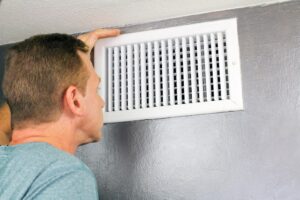If you live in the central or eastern Pennsylvania regions, then chances are you’ve dealt with foggy windows at one point or another. You may have even considered having your windows replaced. But window condensation usually points to a moisture-related problem elsewhere in your home. Fortunately, you can correct these moisture problems by making a few crucial changes to your home.
How Window Condensation Forms
Window condensation usually happens when warm air containing large amounts of moisture suddenly meets a cool surface. The warmer the air, the larger the amount of water vapor it’s capable of holding. As the air rapidly cools, it also loses its ability to hold moisture. The moisture quickly condenses from an invisible vapor state to visible droplets.
Condensation can form on the inside and outside of windows. In some cases, condensation can even form in the void created by double-pane windows. If it’s not dealt with in a reasonable amount of time, it could go on to create mold, mildew and water damage.
What Window Condensation Means for Your Home
Seeing condensation on your windows typically means there’s an unusually high amount of moisture in your home’s indoor air. The problem could be traced back to something as simple as a sharp change in temperature or as complex as a bad heating or cooling system setup. The moisture quickly condenses from an invisible vapor state to visible droplets.
The problem could also be temporary in nature, such as moisture venting from building materials used in a home remodeling project or new construction. Window condensation also happens due to poor ventilation. Without an adequate attic or soffit ventilation system, you won’t be able to push moisture-laden air out of your home and replace it with drier outdoor air.
Preventative Steps You Can Take
If you see condensation on your windows, you can immediately tackle the problem by cracking open a window or two. This lets fresh air inside your home while allowing moisture-laden air to take its leave.
Next, you can lower your home’s relative humidity through the use of a dehumidifier. Bringing relative humidity levels below 40 percent can temporarily solve your window condensation issues.
Not only are there steps you can take to immediately settle window condensation problems, but you can also follow these helpful steps to permanently solve the problem:
- Improve your home ventilation. Inadequate ventilation can actually trap moisture and humidity inside your home. Making improvements to your home’s attic or soffit ventilation is one way of permanently fixing moisture issues. Your home may also benefit from mechanical ventilation, especially if your home was built to be as air-tight as possible.
- Install exhaust fans in high-moisture areas. Your kitchen, bathroom and laundry room are three areas where moisture reigns supreme. Exhaust fans allow you to vent humid air created through cooking, bathing and other common household activities.
- Use curtains and drapes to block heat transfer. Drapes and curtains not only prevent conditioned indoor air from escaping outdoors, but also prevent the circumstances under which condensation forms on windows. This helps prevent condensation during sharp temperature swings caused through seasonal changes.
It’s also important to make sure your windows are installed properly, especially if you plan on using double-pane windows. Make sure your contractor uses the right sealant and weatherstripping during the installation. Otherwise the inert gas normally found inside double-pane windows could leak out and moisture-laden air could make its way in between the panes.
Sullivan Oil & Propane’s preventative maintenance solutions can help, call us today at 610-365-1268.



